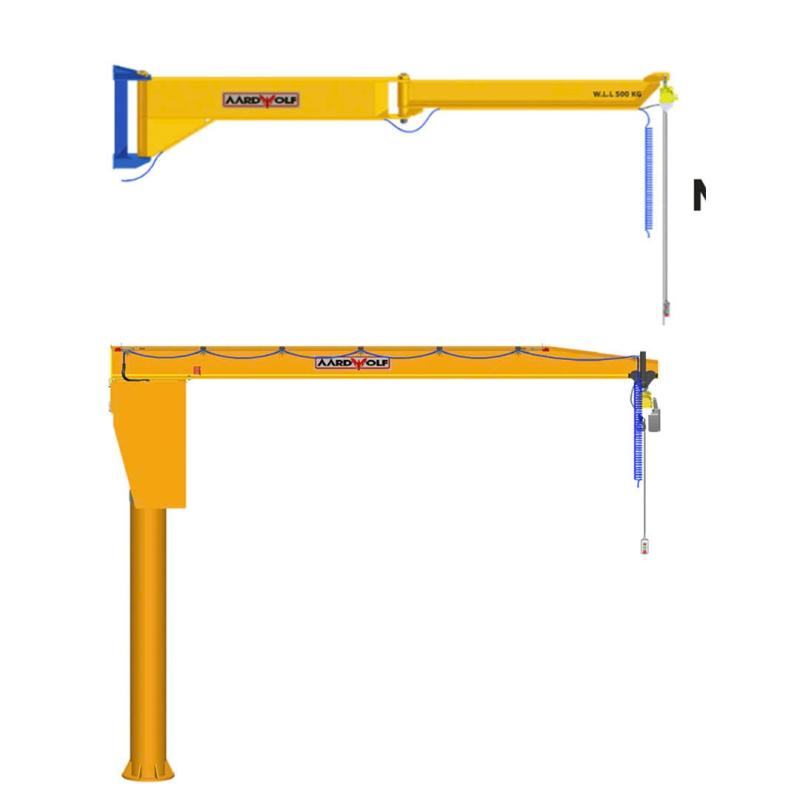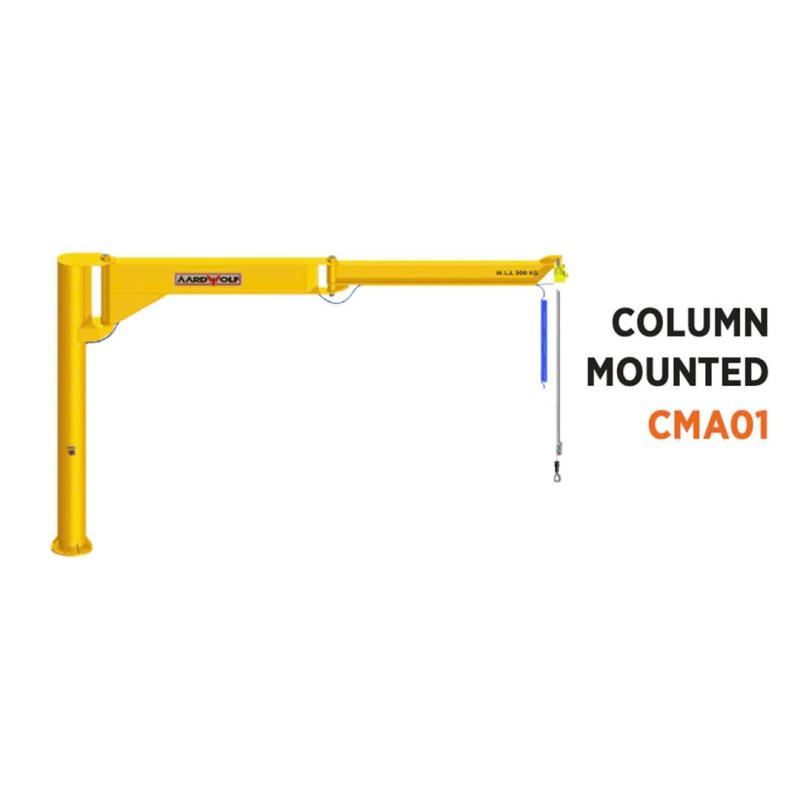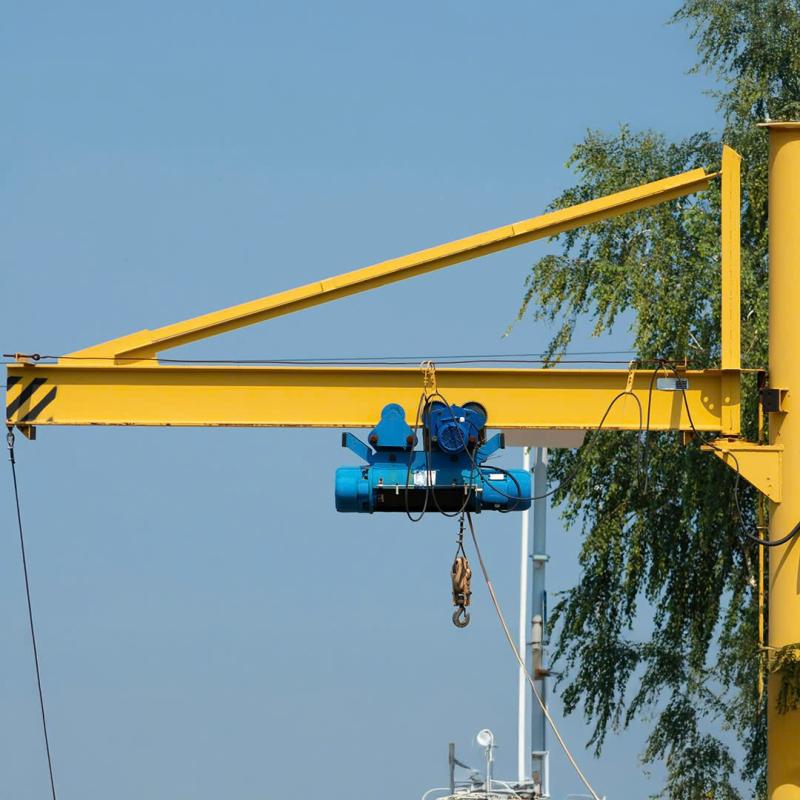



Whether used for assembly, fabrication, repair, or logistics, these cranes provide efficient, ergonomic solutions for localized lifting. However, the key to unlocking their full potential lies in knowing how to operate a jib crane safely and effectively.
This comprehensive guide walks you through the fundamentals and advanced best practices of jib crane operation. It includes crane types, working principles, control systems, safety precautions, and industry-specific examples—all designed to help operators make the most of their equipment while minimizing risks.
A jib crane is a type of overhead lifting device that consists of a horizontal arm (jib or boom) supported by a vertical structure (mast or mounting point). The arm carries a trolley and hoist system that moves materials within a defined radius. Jib cranes are commonly found in:
Manufacturing plants
Fabrication workshops
Warehouses
Maintenance facilities
Outdoor yards
They are valued for their compact footprint, rotational flexibility, and ease of integration into existing workstations or production lines.

Before diving into operation, it’s crucial to understand which type of jib crane you’re working with. Different models offer different levels of mobility, reach, and control:
Example: In a stone fabrication shop, a wall-mounted jib crane with a 4-meter boom is used to lift granite slabs from a storage rack to a polishing table. The limited floor space makes wall mounting ideal.
The operation of a jib crane is based on two core movements:
Vertical lifting via a hoist (manual, electric, or pneumatic).
Horizontal motion via a trolley that travels along the boom, which may also rotate depending on the crane type.
Key components include:
Jib Arm (Boom): The rotating arm that supports the hoist and trolley.
Support Structure: Either wall-mounted, floor-mounted, or ceiling-supported.
Trolley: Carries the hoist horizontally along the boom.
Hoist: Lifts and lowers the load.
Controls: Pendant or remote system used by the operator.
Before you begin, perform a thorough visual and mechanical inspection of:
Jib arm and mounting bolts for signs of fatigue, cracks, or looseness.
Hoist cable or chain for wear, corrosion, or kinks.
Trolley rollers and track to ensure smooth travel.
Control system (emergency stop, directional buttons, variable speed).
Load rating labels to confirm that the load does not exceed crane capacity.
Example: A maintenance technician in a vehicle repair bay discovers a frayed hoist chain before lifting a diesel engine—preventing potential equipment failure and injury.
Tip: Aardwolf AVLP2-500 vacuum lifters are often used in stone and glass shops to gently secure fragile loads and allow safe vertical and horizontal travel.
Example: In a warehouse, an operator uses a remote control to swing a 300 kg crate from a receiving bay to a loading dock using a 5-meter freestanding jib crane.
Ensuring safety is not optional—it is essential. Here are key precautions:
Never exceed the crane’s rated capacity. Overloading risks mechanical failure and injury.
Stay outside the load path. Keep all body parts and personnel clear of suspended loads.
Use proper PPE. This includes steel-toe boots, gloves, hard hats, and safety glasses.
Inspect the crane daily. Check critical points like the hoist, hook, controls, and mountings.
Avoid side loading. Always lift vertically to reduce strain on the boom.
Ensure adequate lighting. Avoid operating cranes in poorly lit areas.
Modern jib cranes offer a variety of control enhancements and safety features:
Push-Button Pendant Controls: Most common; mounted on a cord that travels with the hoist.
Wireless Remote Controls: Increase operator mobility and reduce wear on cabling.
Variable Speed Drives: Provide fine control, especially for delicate load placement.
Limit Switches: Prevent over-travel of the hoist or trolley.
Rotation Limiters: Prevent the boom from swinging into hazards or structural obstacles.
Example: In a cleanroom electronics facility, articulating jib cranes with variable-speed pneumatic hoists and explosion-proof controls are used to move sensitive components.

A properly operated jib crane improves:
Efficiency: Speeds up material flow in production areas
Safety: Reduces lifting-related injuries
Precision: Enables accurate placement of heavy or fragile items
Productivity: Allows a single operator to perform tasks that would otherwise require multiple people
Mastering how to operate a jib crane includes:
Performing regular inspections
Using the right lifting attachments
Controlling movement precisely
Applying safety protocols consistently
Aardwolf Industries offers a complete range of jib crane-compatible lifting equipment, including:
Vacuum lifters for stone, glass, and metal sheets
Forklift-mounted booms and slab lifters
Mechanical clamps for rugged material handling
Custom-engineered hoists and crane arms
Why Choose Aardwolf:
ISO and CE-certified equipment
Designed for high-frequency industrial use
Technical support for integration with jib crane systems
1. How to operate a Jib Crane safely
3. Over brace jib crane wall mounted
5. Is a Jib Crane a Gantry Crane
6. Articulated Jib Crane Wall Mounted
8. Manual Counterbalance Crane
10. Over Braced Jib Crane Column Mounted
11. Powered counterbalance Crane
Sign up to receive the latest info on new Aardwolf products, special offers and more.
By signing up you agree to receive emails from Aardwolf with news, special offers, promotions and other information. You can unsubscribe at any time.